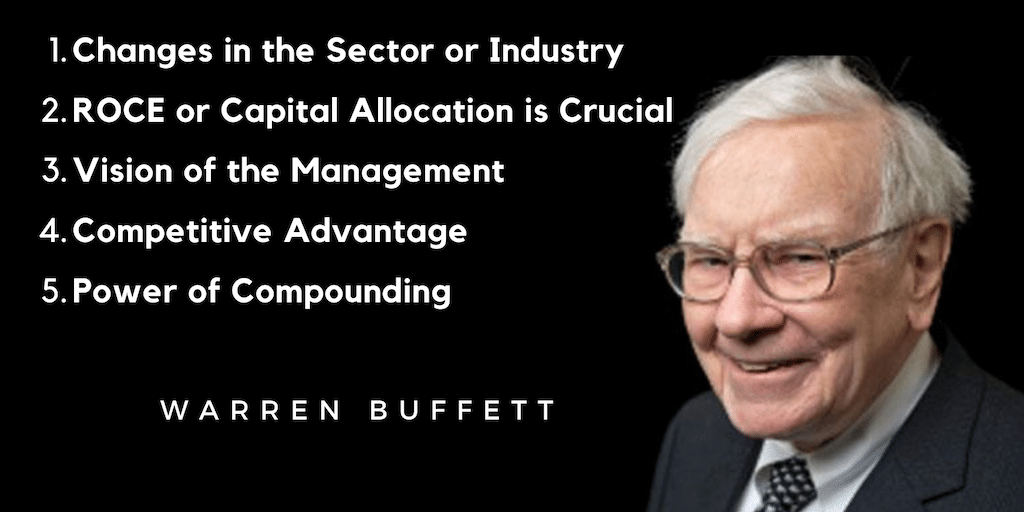There is so much to learn from Warren Buffett and here are 5 key learnings for me from Warren Buffett’s 2020 Letter to Its Shareholder
No matter how much you have read about Warren Buffett, there is so much to learn from everything he has to say or write in his shareholder’s letter, and the letter of 2020 is no different.
You can check out all the shareholder’s letter here, and the 2020 letter to its shareholder is available here.
His letter to its shareholders are jewels of wisdom, and if you can read them, you will master the art of investing for sure.
There are some key learnings for me from Warren Buffett’s 2020 letter to its shareholder, and let me share them with you.
Changes in the Sector or Industry
The first and the most important lesson I learned from Warren Buffett’s 2020 letter to its shareholder is – Industry, or rather a sector is an essential aspect to consider when investing.
I have an Investment checklist and the list of fundamentals I prefer to see in a business.
Once the stock qualifies the above checklist and analysis, I analyse the business with these checklists.
And you will not find my list to cover anything related to the Industry or the business sector.
From Warren Buffett’s 2020 letter to its shareholder, I learned that it is essential to consider the sector.
How the dynamics of the business are changing in the sector.
For example, I always thought Symphony is a great company to invest in. However, I never invested in it because I thought people would prefer an AC over a cooler.
Now when I analyse the sector as a whole, I find that there are so many players making water coolers like Symphony, and the company is feeling the competition. The industry is changing, and competition is getting fierce. There is no USP (unique selling proposition) for Symphony because now we have players like Bajaj and Havells.
There is nothing wrong with Symphony, but the industry dynamics are changing for the company. Will the company be able to rise above the competition or not? Time will tell.
But what is important is one shouldn’t be investing where the business dynamics in a sector is changing, and the market leader has a danger of losing the leadership position.
ROCE or Capital Allocation is Crucial
Time and again, investors emphasise the power of capital allocation and Warren Buffett’s 2020 letter to its shareholder, emphasised it yet again.
Good companies and good management will always try to use the money the business generates in such a way that it is beneficial to the shareholders.
Once the company’s focus and management are to allocate the money in the right areas, the return on the incremental capital employed will be so much higher than the overall ROCE will keep on increasing.
Apple is buying back its shares. Berkshire Hathaway is buying back its shares. These are some of the better ways to allocate capital, as well. But what is essential is the companies should only buy back when it has too much cash being generated and doesn’t find the right avenues to invest in.
A small company that has an excellent road ahead for growth shouldn’t consider buyback. It should rather focus on growth instead, and we will see an example in the next section.
The vision of the Management
When you invest in a company where the management’s vision is not as high as it should be, you will not progress.
So let me share examples of the vision of the company. Again, none of the companies I share is a recommendation. I am sharing to understand Warren Buffett’s 2020 letter to its shareholder.
Waterbase Vs Avantifeed. The management of Avantifeed had the vision to be the no1 shrimp exporters, unlike Waterbase, focusing on stock buybacks. I invested in Waterbase because management was top class, but I missed the management’s focus. It was to own a large chunk of their business before they take the growth plans.
Competitive Advantage
One should invest in companies that have a high degree of competitive advantage.
Some companies have so much competitive advantage over others.
Let me share the example of Bajaj Finance and Finserv or HDFC Bank. Again, there is not a recommendation but to help understand the competitive advantage of companies.
The cost at which these companies can borrow money is so much lower than others that they disburse loans at a rate that other companies borrow.
So these companies are giving a loan to customers at under 7%. Smaller NBFC’s are borrowing money at a rate much higher than 7%.
So when those NBFC want to compete with these giants, they will have to make a loss.
Power of Compounding
Finally, you can’t have a Warren Buffett’s shareholder letter without the 8th wonder of the world, which is compounding power.
Warren Buffett’s portfolio has a Compounded Annual Gain–1965-2020 of 20% compared to S&P gaining only 10%.
It doesn’t look that impressive, but when you look at the Overall Gain–1964-2020, you will be shocked that S&P has a return of 23,454%, whereas Warren Buffett’s portfolio has a return of 2,810,526%.
Almost 120 times more.
That is the power of compounding at a higher rate by only 10% points compared to the market for 55 years.
Final Thoughts
What are some of your key learnings from Warren Buffett’s 2020 letter to its shareholder? Please share them in the comments below and let everyone learn about them.




Leave a Reply